Report

Executive summary
Digital technologies are causing disruption across the global automotive industry. From digital engineering and 3-D printing to smart sensors and the Internet of Things (IoT), digital is poised to disrupt automotive R&D, manufacturing, sales, marketing and post-purchase services.
The sector will witness the emergence of new players, such as software and mobility platform providers with nontraditional advantages, who will gain an increasing share of sector profits. Bain estimates that profits from automotive original equipment manufacturers’ (OEMs) traditionally core activities like vehicle engineering, manufacturing and sales could drop by about 8% from 2015 to 2025, even though industry profits are projected to grow about 35% in that same time frame.
While the implications of digital span every part of the automotive value chain, this report will focus mainly on its effect on the automobile customer. We have evaluated the digital influence on the customer’s purchase journey and explored the role that product digitisation will play. With this in mind, we also explored auto customers’ changing mindsets and attitudes towards mobility.
To understand their decision-making process and key influencers, we surveyed 1,551 Indian customers who had purchased a vehicle in the last 12 months. We supplemented that with a survey of 87 dealers and conversations with top management teams from various automakers. We also drew insights from Bain’s Global Automotive Consumer Survey that included respondents from the US, the UK, Germany, China and India.
Our research reveals that the nature of the game is changing. Technology and new players in the industry are redrawing battle lines in the fight for the customer’s mindshare and, in the long term, the fight for relevance in the mobility space.
The fight for the customer
Almost 70% of annual auto sales (about 19 million units, generating $40 billion) will be digitally influenced by 2020, an almost 2.3x increase from today’s $18 billion per year. And automotive OEMs lag in adjusting their investment mix.
- Social media and search are the top digital influencers: Each will influence about 40% of sales (11 million units, about $23 billion in revenue) by 2020, up from 20% (4 million units, about $7 billion in revenue) today.
- Mobile will continue to dominate the device mix: Almost 80% of online research is currently conducted on mobile phones. This is expected to continue to rise in the coming years as market factors cause an increase in the penetration of smartphones and mobile data connections.
- High digital influence is shaping brand consideration: Digital will influence consideration in about 60% of consumers by 2020, up from almost 45% today.
- Younger customers will lead the digital charge: 49% of consumers younger than 35 report that digital influences their consideration set, compared with 40% of those older than 35. As this cohort ages and a new young cohort enters the market, digital influence is set to increase.
- The role of the dealer is evolving, especially for four-wheeler vehicle buyers: Almost 50% of buyers have made a decision on both brand and model before visiting a dealer.
- Post-purchase activities are the next digital frontier: By 2020, up to 40% of consumers are expected to book services online and about 30% will go online to purchase accessories, up from 14% and 8%, respectively, today.
Most Indian automobile OEMs are behind the curve in digital investments; they spent 10% to 11% of their total marketing budgets on digital media in 2016. Automotive OEMs must redefine their marketing and customer engagement efforts to reflect the current behaviour and usage patterns of automobile buyers.
The fight for relevance
As mobility mindsets evolve, disruptive mobility models and new competitors create threats and opportunities for OEMs.
- New mobility models are gaining growth and acceptance. More than 40% of lead consumers report using app-based taxi services like Ola and Uber more than three or four times per week. Experiences in other markets indicate significant room for growth: India’s annual rides per capita (adjusted for cities where these operators are present) is 3.3, compared with 17.1 in China.
- Other models that affect different aspects of the mobility landscape, such as route optimisation (for example, Zophop) and public transportation (such as Cityflo and RedBus), are also likely to experience growth.
While the demand for automobile ownership in India will likely remain robust, we will continue to see the proliferation of alternative mobility models. OEMs must begin to think of themselves as mobility providers rather than vehicle manufacturers. This shift will entail a strategic evaluation of which parts of the mobility market will remain relevant to the new auto consumer.
We anticipate five critical imperatives for automotive OEMs to consider in this new competitive landscape:
- Follow the profit: Evolve business models to tap into shifting profit pools. Explore partnerships and targeted investments both forward and backward in the value chain to participate in profitable future businesses, such as connectivity software and mobility platforms.
- Follow the customers: Radically change the investment mix to move online with them. Increase the proportion of digital marketing investments with a disproportionate focus on discovery and consideration.
- Build the dealership of the future: Differentiate the retail format. Convert dealerships into brand experience centres by developing differentiated retail formats with innovative virtual-physical layouts.
- Change the game: Use product digitisation to enable deeper ongoing customer relationships. Move from one-time engagement to ongoing relationships by offering services like pay-per-use insurance and smart maintenance.
- Invest in the backbone: Build data and analytics capabilities. Build the capability to integrate data from multiple sources and perform the right analytics.
Download the Executive Summary (pdf)
Evolution to revolution
The global automotive industry has witnessed mostly incremental “evolutionary” innovations in the course of its 130-year history. Disruptive changes in production techniques, business models and categories—such as Henry Ford’s innovation of the assembly line or Hal Sperlich’s introduction of the Chrysler Minivan—have been few and far between.
This traditional paradigm is rapidly changing with the advent of digital disruptions across the value chain (see Figure 1). Digital engineering and 3-D printing are shrinking product development timelines and costs. Smart sensors combined with complex computational capabilities are enabling new feature designs, like advanced driver assistance systems (ADAS), which have the potential to make travelling by car safer. Data transmitted from cars to OEMs encourages preventative maintenance and results in safer and more efficient vehicles.
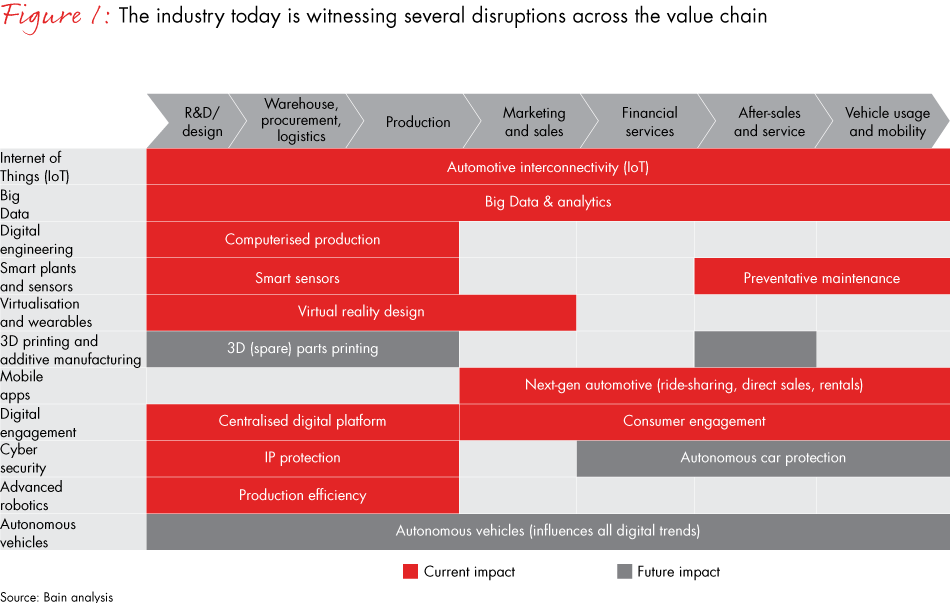
Digital channels are also redefining customer engagement. Customers research online, buy online and share their experiences online. They also remain connected after the purchase via their infotainment systems for content, to OEMs for real-time design feedback and to dealers for service alerts. The growth of mobile apps and platforms has led to the next generation of automotive applications: a range of new mobility options including ride-sharing and new rental formats.
New kids on the block
One of the most profound implications of these disruptions is the rapid growth of new mobility players from outside the traditional automotive industry. For example, app-based cab aggregators have become an integral part of the mobility ecosystem and have attained large customer bases and multibillion dollar valuations in very short periods of time. And news reports suggest that in its seven-year existence Uber has attained a market capitalisation of about $70 billion.1 Similarly, Quanergy, a producer of LiDAR sensors that enable deployment of autonomous driving systems, has reached a valuation of $1.6 billion in only four years. The growth of these players is transforming the traditional automotive landscape.
Over time, this shift in business models and sources of competitive advantage will transform the auto industry’s profit pools. According to Bain estimates, global profits from vehicle engineering, manufacturing and sales will be redistributed by about 8% through 2025 despite overall industry profit growth of about 35% in the same period. Industry profits are being redistributed to players like components and systems suppliers, which provide increasingly sophisticated solutions, as well as to nontraditional competitors like mobility platform providers.
The changing automotive customer
The Indian consumer is evolving into a digitally savvy and largely mobile-first user. India has more than 400 million Internet users—more than the US and second only to China. This makes it an increasingly important market for online companies. Facebook had roughly 184 million active users in India as of December 2016, compared with 209 million in the US.
People mainly use their mobile devices to access the Internet, and this is no longer restricted to “metro” India:
- The number of rural mobile Internet users has grown by about a 130% compound annual growth rate (CAGR) over the past four years, and it now accounts for nearly 30% of total mobile Internet users.
- In India, 97% of active Facebook users access the social network site using a mobile device; the corresponding number in the US is 93%.
These trends will only accelerate. A recent NASSCOM (National Association of Software and Services Companies) study projected that India would have 730 million Internet users by 2020 and 75% of new Internet user growth would come from rural areas.2 Smartphone penetration is projected to double between 2015 and 2020 to about 30%, while mobile commerce (m-commerce) sales are projected to increase by about six times to $38 billion in the same period. All these changes will have a profound effect on the automotive consumer’s journey.
New opportunities in the automotive customer’s journey
Digital technologies are changing the manner in which customers engage with automotive OEMs across the purchase journey—from product discovery and consideration to research, purchase and post-purchase transactions.
Discovery, consideration and research
Digital influence is currently highest in this phase of the purchase journey. More than 45% of consumers say that digital channels influenced their consideration set while 48% used online research sources. Observations from lead consumers indicate that this number will grow. According to Bain estimates, about 70% of total automobile sales—or $40 billion—will be digitally influenced by 2020. This represents more than a doubling of digitally-influenced sales from today (see Figure 2).
Of those digital sources, online search, OEM websites and social media have the biggest influence today. That picture is likely to change by 2020 as search and social media evolve into the dominant digital influencers (see Figure 3). Each will impact almost 40% of sales or about $23 billion in revenue. This digital advent will be largely mobile based: More than 80% of all online research will be conducted via mobile phones.
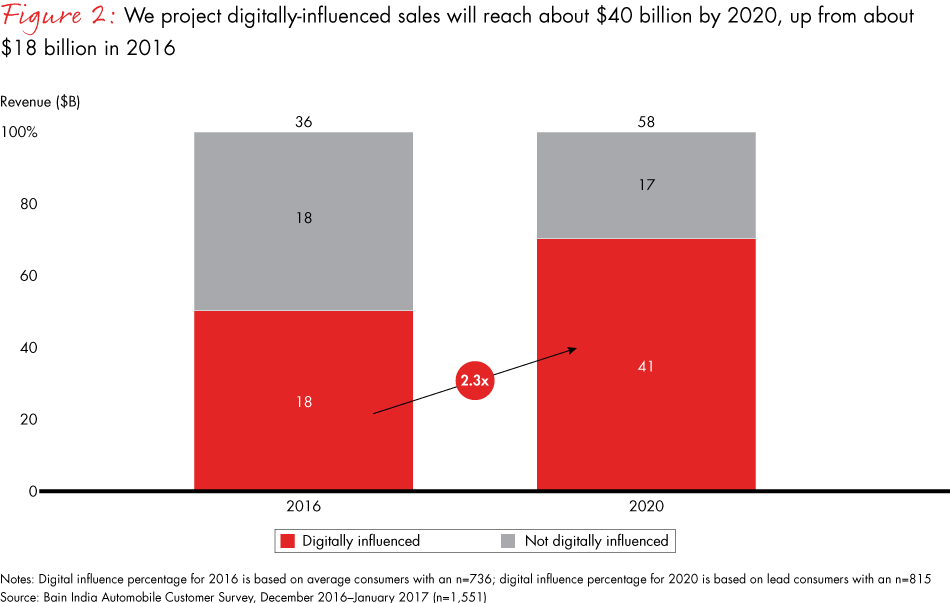

Younger customers will lead the digital shift. Digital channels influenced the consideration set in 49% of consumers younger than 35 and 40% of those older than 35. As more young buyers enter the market in the coming years, we are likely to see an acceleration of digital influence. Brands targeted towards these younger consumer groups have the greatest imperative to increase the scale and scope of their digital marketing efforts.
The dealership visit and evolving role of the dealer
The role of the dealer is also significantly changing as a result of shifts in digitally-influenced customer behaviour. Dealers have traditionally played an important role as an information source and an influencer in customers’ purchase decisions. This is changing: 72% of customers have selected a vehicle brand and 49% have chosen the vehicle model before stepping into a dealership (see Figure 4). As a result, the dealer’s contribution is often limited to influencing the variant of the vehicle purchased.
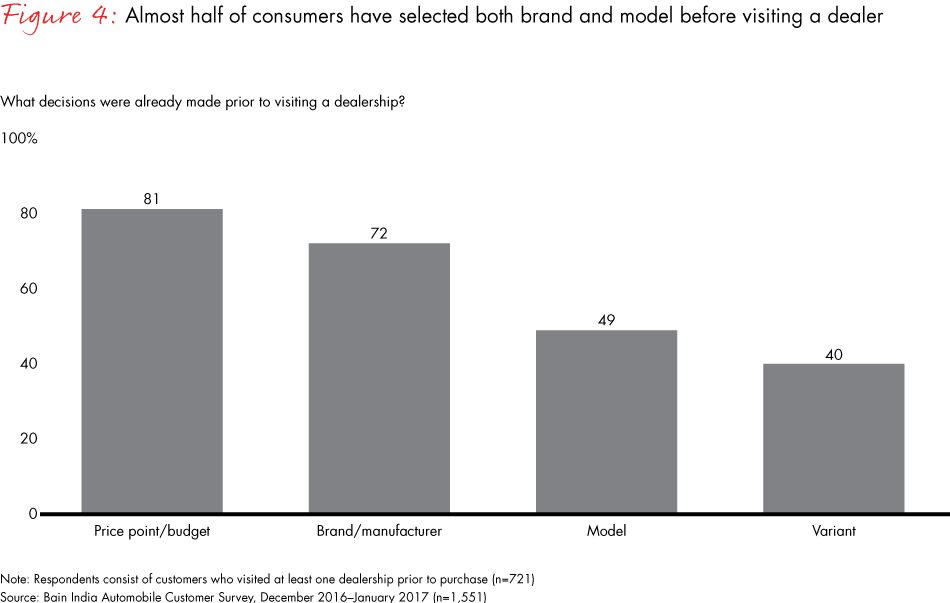
Further, Bain’s Global Automotive Consumer Survey shows that 66% of Indian consumers are willing to try devices that use virtual reality (VR) or augmented reality (AR) to test drive vehicles. That is significantly higher than in developed markets—21% in both the US and UK and 26% in Germany. This indicates that Indian consumers have a high willingness to adopt technologies that alter the traditional dealer role.
Dealers have started to shift towards better digital engagement with their customers, but need to enhance the sophistication of their digital outreach. For instance, more than 80% of the dealers surveyed use bulk SMS and bulk emails as a core part of their customer-targeting process. This ignores the depth and accuracy of targeting that is possible with digital tools.
Purchase and post-purchase
While digital channels are used extensively in the pre-purchase process, fewer than 1% of respondents have completed the actual purchase of their vehicles online. That mirrors global trends: For example, fewer than 4% of customers in markets such as the UK and Germany say that they have purchased a vehicle online. That number is likely to remain low in the near future because the size of an automobile purchase tends to be a transaction that requires an actual physical touch point.
While the actual purchase is likely to remain offline in the foreseeable future, Indian consumers have started moving online for various post-purchase transactions such as booking a service (14% of consumers), paying for vehicle service (10%), buying spare parts and accessories (8%) and organising a pickup or tow (3%). While these numbers lag those of pre-purchase activities, it is clear that the digital shift has begun.
Willingness to go digital
While the pre-purchase journey already shows a high digital influence, the next big shift will happen in post-purchase activities. Up to 42% of consumers indicate a willingness to move service booking online, and about 28% indicate willingness to move service payment and purchase of accessories online (see Figure 5).
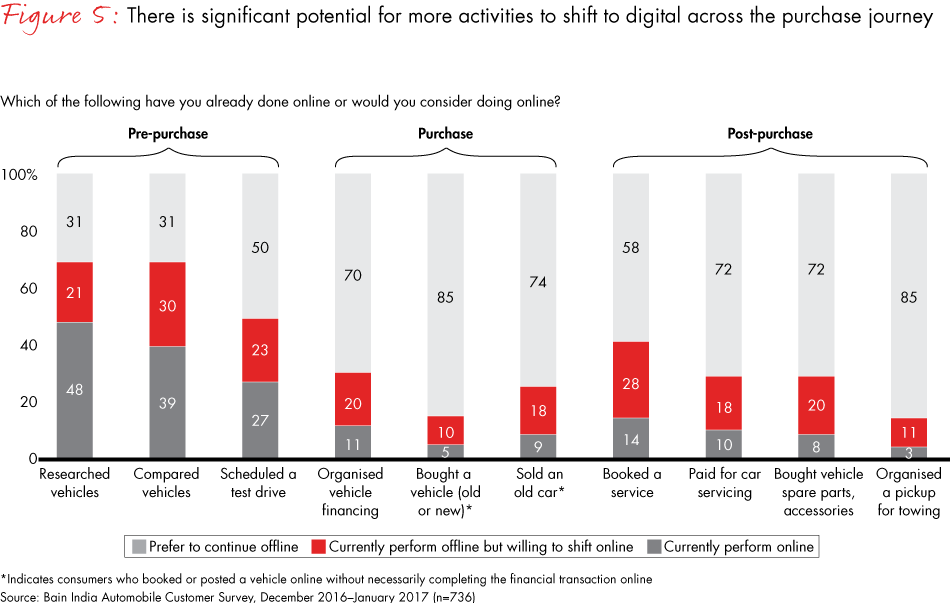
Our global research also shows that Indian and Chinese consumers have a greater willingness to shift multiple parts of the purchase online compared with their peers in the US, the UK and Germany. This indicates the possibility of some digital “leapfrogging” in markets like India and China with more rapid digital movement than expected given other economic and social factors.
For instance, 64% of Indian automotive customers are willing to move the purchase process completely online or mostly online (with a call or personal interaction), while in the US and the UK, that number is only around 30%. Potential to leapfrog in the Indian and Chinese markets is also evident in a customer’s greater willingness to adopt nascent technologies, such as virtual reality or augmented reality, than those in developed markets are (see Figure 6).
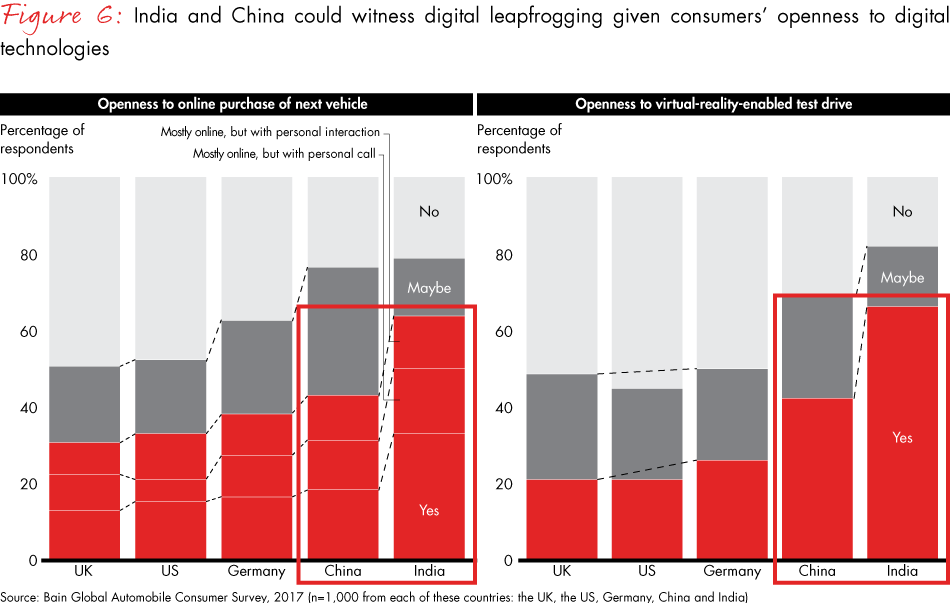
These findings indicate that a significant digital shift has already occurred and that much room still exists in customers’ use of digital across the purchase journey. In our interviews with customers, experts and automotive CEOs, we consistently heard of the need to evolve current models to achieve a seamless offline and digital approach to better engage and serve the emerging automobile customer.
Engaging beyond the purchase: Connected vehicles
Digitally connected vehicles are no longer a nascent concept in the developed world, and some of these changes are relevant in the Indian context. Today’s cars have an onboard computer and smart sensors, and high-speed mobile data connections to transmit information are prevalent. To engage customers, automotive OEMs must develop the capability to effectively process this information and translate it into useful services.
Globally, automotive OEMs have made significant advancements in using connected vehicles to improve customer engagement. For instance, BMW ConnectedDrive is a personal mobility assistant that syncs with the customer’s smartphone for meeting schedules, infotainment, route and time optimisation as well as warnings and alerts.
Likewise in India, connectedness is becoming increasingly relevant with both start-ups and established auto OEMs making moves in the space. Nissan recently launched a connectivity device that was made available to new and existing customers starting in 2017. The device offers functionalities that include live updates on maintenance needs, as well as the ability to book service appointments and order spare parts.
A host of technology start-ups, such as CarIQ, Trak N Tell, Carnot Technologies and Elsys Intelligent Devices, have also entered this space with add-on connectivity devices that work with older cars through mobile apps. For example, Carnot Technologies offers a plug-in device that analyses data from vehicle sensors and transmits it to the customer’s smartphone. In addition to live GPS tracking and SOS alerts to emergency contacts in case of an accident, the app monitors the health of the car, sending alerts to customers when required. Over time, the app logs customers’ driving data and provides suggestions for enhancing vehicle longevity.
The connected vehicle opportunity has also garnered the attention of leaders from other industries that specialise in software and IT capabilities. Google and Apple entered the connected car space with their Android Auto and CarPlay mobile platforms, respectively, which enable integrating customers’ smartphones with the vehicles’ dashboards.
Product digitisation has created powerful methods for automotive OEMs to continue the customer relationship after the purchase. They would do well to seize this opportunity for customer advocacy, moving away from traditional “episodic” engagement to continuous engagement with their customers.
Bain Partner Yaquta Mandviwala explains how Indian OEMs can increase overall digital presence to strengthen their relationships with customers.
Changing customer mobility mindsets
The adoption of digital technologies is extending beyond the purchase process and in-car experience. Structural changes such as urban congestion combined with technology enablers are leading to the emergence of new types of mobility solutions and shifts in the mobility mindsets of customers.
Consider app-based cab aggregators like Ola and Uber. Virtually nonexistent in 2013, they collectively grew to account for an estimated 13 million weekly rides by the end of 2016. More than 40% of lead consumers report using app-based taxi services like Ola and Uber more than three or four times per week (see Figure 7). Global analogs indicate significant potential for further growth. Average annual rides per capita in India (adjusted for cities where these operators are present) was an estimated 3.3 in 2016. This is significantly lower than China (17.1) with which India shares several structural causes of car-sharing: mega cities, traffic congestion and parking shortages. All these factors indicate that we are likely to witness a significant increase in car-sharing there in the coming years.
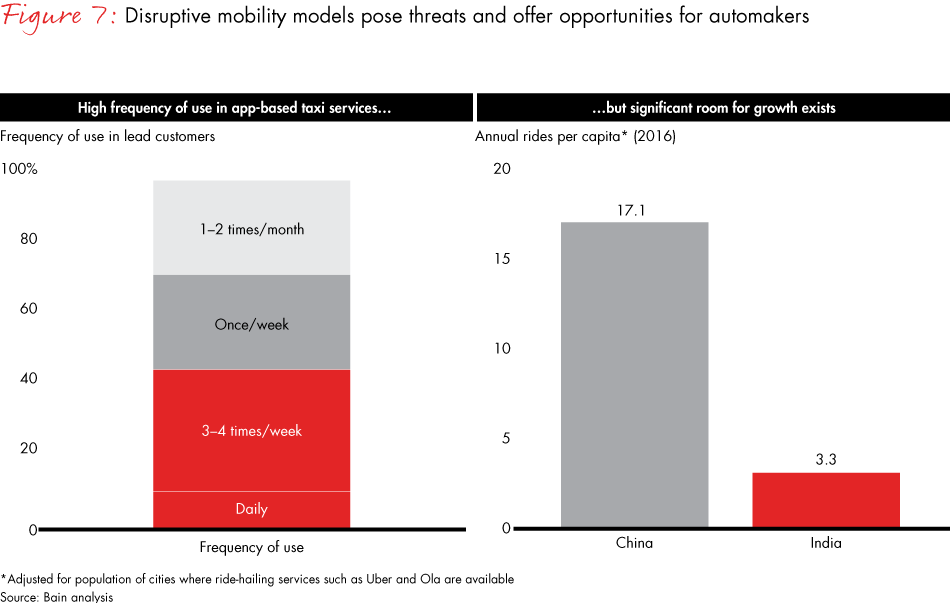
Multiple players have also emerged to meet specific needs in the increasingly multi-modal mobility ecosystem. Bike taxi apps such as Rapido, Baxi, M-Taxi and, more recently, UberMOTO, offer last-mile transportation and delivery services. Other offerings help commuters choose the most efficient route across different modes of transportation and enable making easy reservations from a unified platform. Zophop is one such start-up that does route optimisation across buses, passenger trains, metro rail, autorickshaws and taxis with live ETA updates and smart ticketing. Cityflo and RedBus tap into the demand for convenience within the public transportation system by offering apps that enable bus pooling and seat reservation.
Examples from other markets indicate that some of these models are likely to evolve into more comprehensive mobility solutions. GO-JEK, a digital platform for aggregating informal motorcycle taxis in Indonesia (ojeks in Indonesian), started out as an on-demand provider of ojek driver services to commuters. Over time, the perception of ojeks evolved from mere bike taxis to providers of mobility solutions. This shift has resulted in GO-JEK branching into many transport-related areas, including food delivery, on-demand groceries and supplies, logistics, medicine delivery and more.
Growing impact: Auto OEMs react
An automobile is still an aspirational purchase in India, and demand for car ownership is expected to remain robust. However, these shifts in the overall mobility market are changes that OEMs cannot ignore in the long term.
Globally, auto OEMs have started responding to these changes by investing in new business models—such as General Motors’ $500 million investment in point-to-point (P2P) service provider Lyft—and experimenting with partnerships. For example, DriveNow is a car-sharing joint venture between BMW and Sixt SE, whose operations are mainly in Europe today. The business model is a “free-floating” service, with an emphasis on premium vehicles that allows vehicles to be picked up and left in designated areas. The platform eliminates the need for a physical rental office, and allows customers to locate and unlock available cars using a smartphone app.
Some OEMs operating in India have also started taking measured steps in this direction: Mahindra, Ford, Toyota and Nissan have entered into partnerships with Uber and Ola to provide easy financing and other driver benefits. However, more needs to be done. While it is difficult to predict the end-state of the mobility mix that Indian consumers will want in the future, it is clear that newer mobility models are here to stay. Indian OEMs must take a strategic long-term view on how best to participate in this evolving mobility space, and make investments now in order to be the disruptors rather than the disrupted.
The way forward: Implications for OEMs
Given these shifts, five critical imperatives emerge for automotive OEMs to thrive in this changing landscape.
Follow the profit: Evolve business models to tap into shifting profit pools
The auto industry’s profit pools are being redistributed to new types of players that have distinct strengths that are usually far removed from the core automotive OEM capability of engineering. The greatest profit shifts are towards manufacturers of components and software solutions, as well as newer mobility service providers. It may not be feasible for OEMs to develop these capabilities entirely in-house. They must, therefore, forge unconventional partnerships and make selective investments in key parts of the value chain.
The business models for these new areas are still evolving in India. It is critical for automotive OEMs to be selective about the opportunities where they invest, create an internal culture of experimentation and focus on developing a credible business model in the medium to long term.
Follow the customers: Radically change the investment mix to move online with them
Automotive OEMs in India currently allocate 10% to 11% of their total marketing budgets on digital media, compared with about 35% in the US, 55% in China and 25% in Mexico. Internet penetration in India is projected to increase from 26% in 2015 to 42% by 2020. Consumers are already shifting multiple parts of the purchase journey online (see the section, “The Changing Automotive Customer”). Automotive OEMs need to take decisive action to increase the allocation of marketing investments to digital channels. Bain estimates indicate that companies should increase the proportion of their budget for digital marketing to about 25% to 30% of their total marketing spending by 2020. This will result in a digital marketing opportunity of $250 million to $300 million by 2020.
Discovery and consideration are important areas to focus digital spending. Most customers today have made a brand choice long before they visit a dealer. This highlights the importance of investing in the early part of the purchase journey. Digital channels allow for accurate and predictive content targeting to influence consideration. Given the vast amounts of data that customers generate online, digital channels provide automotive OEMs the ability to target “segments of one” with the right marketing content relevant to the stage of the purchase process (see Figure 8).
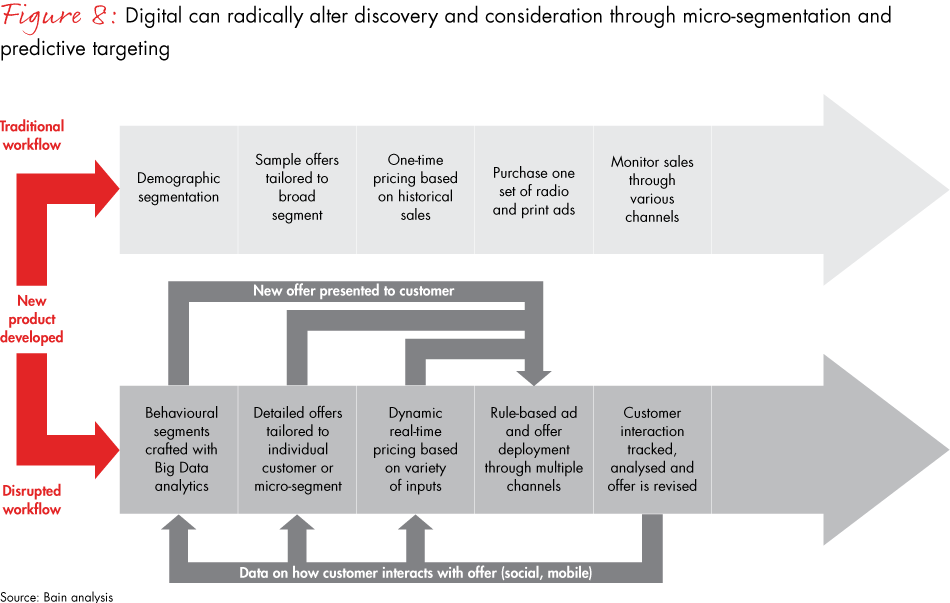
A good example is Chevrolet’s relaunch of the Cruze model through social media channels in February and March 2016. Chevrolet wanted to reach its target audience on a massive scale with the aims of increasing brand recall, brand favorability and purchase intent for the car. It ran photo ads in the mobile and desktop news feeds of target customers to showcase the specifications of the new Cruze. Behaviour targeting was used to deliver ads to a highly specific customer segment, such as those with certain travel habits, mobile phone ownership or a demonstrated affinity for high-value goods. A Nielsen Brand Effect study to measure the campaign’s results demonstrated an eight-point lift in ad recall (72% higher than the global benchmark for the auto industry), a three-point lift in brand favorability (45% higher than the global benchmark) and a seven-point lift in purchase intent (97% higher than the global benchmark), resulting in a total of 7.3 million people reached.
Build the dealership of the future: Differentiate the retail format
OEMs must think about how to differentiate the offline brand experience. Globally, OEMs are already running experiments with “exciting” retail formats such as creative stores in high-street locations run by product experts with interactive virtual-physical layouts. The idea is to convert a dealership from a simple outlet to a brand experience centre. Many design options are possible: a combination of innovative store layouts, point-of-sale digital tools (handheld devices, tablets and VR/AR devices) and product touch-and-feel options such as colours, leather and metals.
For example, in late 2014, Hyundai launched a first-of-its-kind digital automotive retail experience: Rockar Hyundai.3 The idea of providing customers with the entire gamut of activities involved in purchasing and owning a car—from research and test drive to purchase, and then selecting financing options and exchanging their old car—at the touch of a button took the form of the 24/7 website, accessible through computers, tablets and smartphones. A physical store in a highly visible location complemented the online portal. Trained and knowledgeable “Rockar Angels” replaced traditional salespeople—but only as needed to ensure that the customer was in complete control.
Change the game: Use product digitisation to enable deeper ongoing customer relationships
Connected automobiles are a powerful way to remain connected with customers post-purchase. It is increasingly possible for companies and consumers to communicate in real time, taking customer engagement to a higher level.
We expect to see four broad categories of connected vehicle services that are most relevant in the Indian context:
- Smart service and maintenance: predictive and dynamic maintenance of vehicles, automated service reminders, vehicle health monitoring and pre-ordering parts online
- Location-based and emergency services: navigation and traffic alerts, fleet operations, breakdown support, security service and facility searching (petrol pumps and restaurants)
- Usage-based services: customised insurance programmes based on mileage and vehicle health, driving style support and fuel optimisation tips
- Infotainment services: in-car delivery of music and television shows, downloadable applications, smartphone integration, voice and communication services and social media integration
We believe that India’s auto OEMs have traditionally been conservative in terms of providing access to their core technologies beyond Tier-I suppliers and in encouraging partnerships beyond vendor relationships. A move towards providing more access to their platforms will allow them to better develop software and systems to connect to their customers.
Invest in the backbone: Build data and analytics capabilities
The power of analytics that use internal data from various sales and marketing touchpoints, along with external data available through social media and search, is well understood. While it is critical to develop the business case and applications for analytics solutions, the true complexity is in the data layer. With the growing amount of data from disparate sources, it is critical to invest in a well-designed data and meta-data layer with clearly defined objectives of the system, along with the right technology solution (see Figure 9). Doing so will help automotive OEMs fully harness the power of digital technologies.

Making it all work
Based on the disruptions that digital technologies are causing, OEMs need to develop new capabilities across functions and levels. However, the magnitude and rapidity of the change and learning required can be overwhelming.
To enable organisations to start developing the required digital capabilities, Bain applies a Test-and-Learn approach. We work with smaller experiments to break this big transformation into bite-sized pieces. This enables rapid testing of many variables simultaneously, speeding up learning and cracking the code on what drives consumer behaviour. Ultimately, it also builds the organisational capabilities so that experimentation becomes a repeatable embedded process.
Global and Indian OEMs’ success will depend on their willingness and ability to view digital not as an afterthought but as a powerful way to engage existing and prospective buyers. Only then can OEMs truly harness digital’s potential and build profitable relationships for the duration of their customers’ ownership journeys.
Appendix: Primary research
This report relies on four primary studies performed among automobile consumers, dealers and top management teams of automotive OEMs in India.
The first of our studies, a quantitative survey, queried 815 “lead” consumers and 736 “market representative” consumers across India to understand their interaction with online and offline channels as part of their pre-purchase, purchase and post-purchase journey. The study also enabled us to assess consumers’ willingness to switch to online channels and understand the key challenges in moving the journey online.
Lead consumers are those using the Internet at least once a week, residing in Metros, Tier-1 and Tier-2 cities, and categorised under the New Consumer Classification System (NCCS) grades A and B. Market representative customers are those residing in Metros, Tier-1 and Tier-2 cities, with any level of Internet usage and belonging to any NCCS grade. Throughout the report, all numbers for 2016 reflect findings from the market representative sample, while numbers for 2020 reflect findings from the lead consumer sample. All consumers surveyed had purchased a new vehicle in the past 12 months and were the primary decision makers in the purchase process.
The second of our surveys was conducted across five countries: India, China, the UK, the US and Germany. It was conducted only with online respondents who had purchased a vehicle in the past 24 months (1,000 respondents in each country). The objective was to understand the customer journey at a global level and draw comparisons with regard to the number of total touchpoints, the level of influence of each touchpoint (online/ offline) and a willingness to switch to new technology such as VR and other digital channels.
In our third study, we interviewed 87 automobile dealers across India. Our aim was to understand dealers’ views and use of digital technologies to engage with current and prospective customers.
Finally, we followed these up with in-depth interviews of CXOs at leading OEMs in India to understand their plans, concerns and strategies for the digital future of the automotive industry.
Download the Executive Summary (pdf)
About the authors
Srivatsan Rajan is chairman of Bain & Company’s India offices. He is an active contributor to the firm’s Customer Strategy & Marketing practice. Joydeep Bhattacharya is a partner in Bain & Company’s New Delhi office. He is the head of Bain India’s Consumer Products and Retail practices. Yaquta Mandviwala is a partner in Bain & Company’s Mumbai office. She leads Bain India’s Customer Strategy & Marketing practice. Deepak Jain is a partner in Bain & Company’s New Delhi office and is a member of Bain’s Industrial Goods & Services practice.
Acknowledgements
A joint team from Facebook India and Bain & Company, India conducted this study. The key members of the Bain team are Srivatsan Rajan, partner; Joydeep Bhattacharya, partner; Yaquta Mandviwala, partner; Deepak Jain, partner; Aarthi Rao, Arup Mazumdar, Preeti Kumar, Krithika Sriram, Siddhant Mittal, Ankur Sarpa, Dushyant Khanduja and Shashank Jain. The Facebook India team members are Umang Bedi, Prasanjeet Dutta Baruah, Sudarshan Sarma, Balendu Shrivastava, Aditi Nargundkar and Sunita G.R.
The team would like to thank all the companies, executives, employees and experts that generously shared their perspectives with us. We would also like to thank Bain & Company global partners for their expertise and input on various global case examples.
1 “From Zero to Seventy (Billion),” The Economist. http://www.economist.com/news/briefing/21706249-accelerated-life-and-times-worlds-most-valuable-startup-zero-seventy, accessed April 25, 2017.
2 Rural India to power Internet users to 730 million by 2020, NASSCOM-Akamai, accessed Dec 2016, http://www.livemint.com/Politics/eMr4D5XFQWTMboKzOOgQLL/Rural-India-to-power-internet-users-to-730-million-by-2020.html
3 “An All-New Way to Buy a Car.” https://www.hyundai.news/eu/brand/an-all-new-way-to-buy-a-car-rockar-hyundai/, accessed April 25, 2017.








